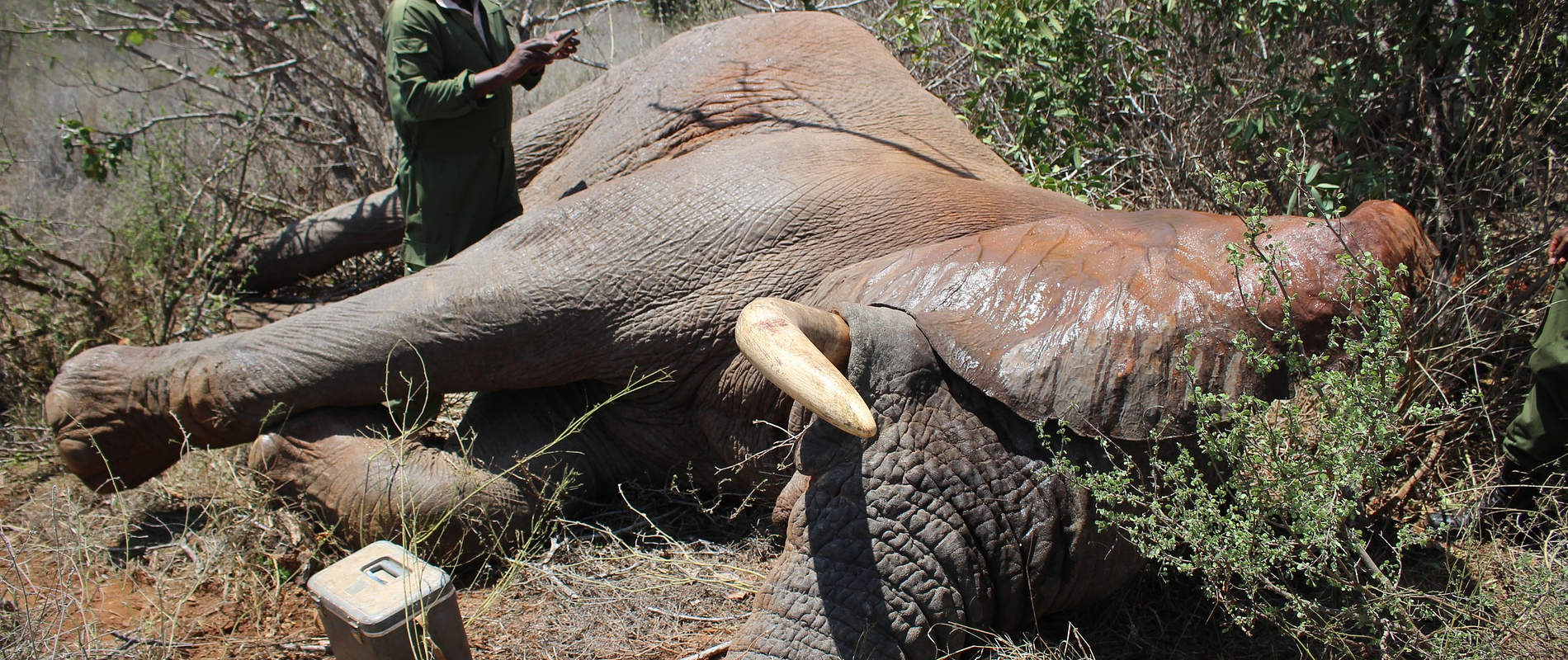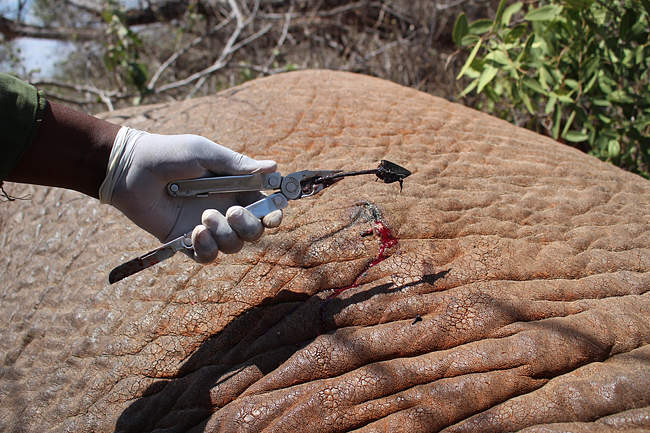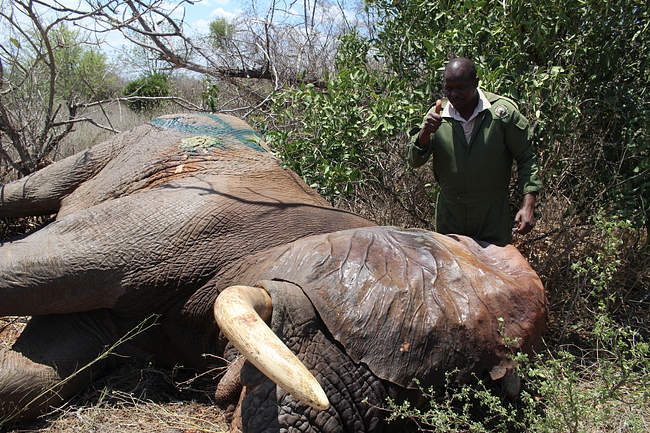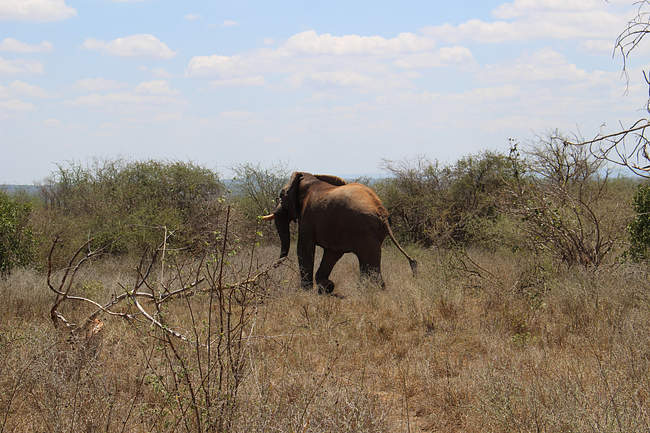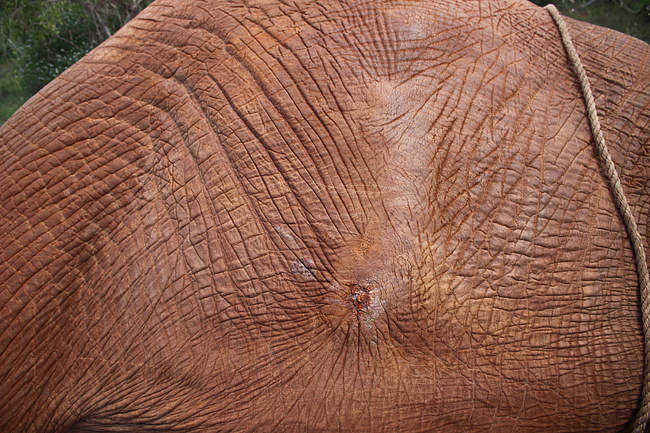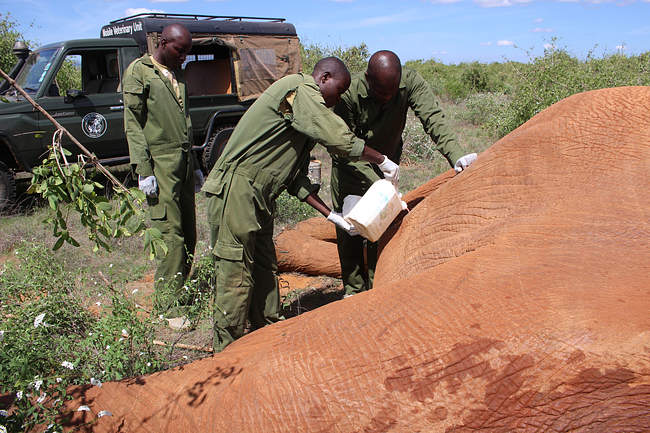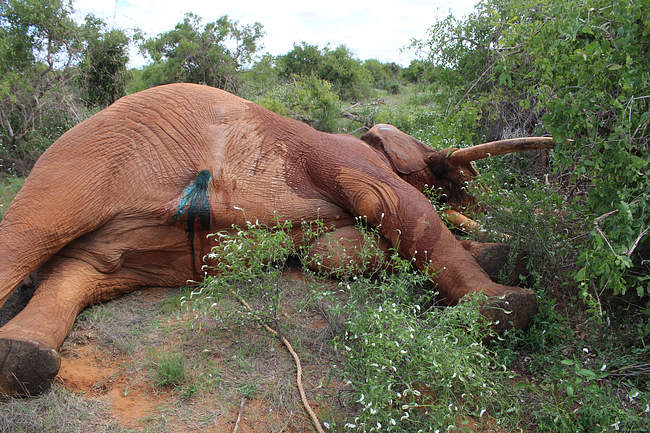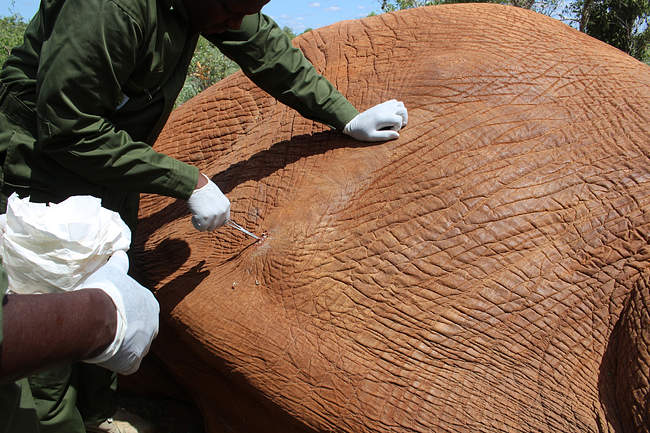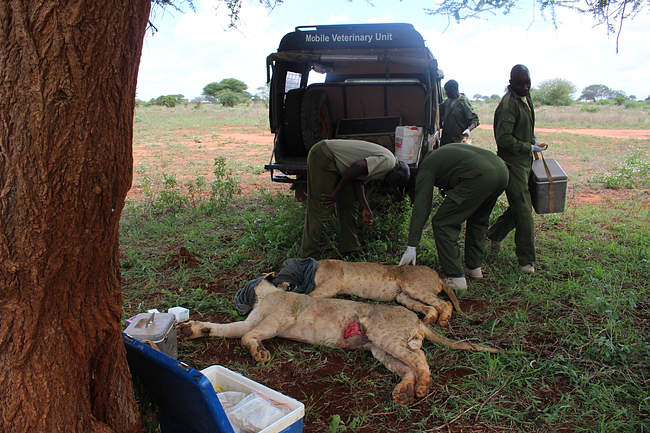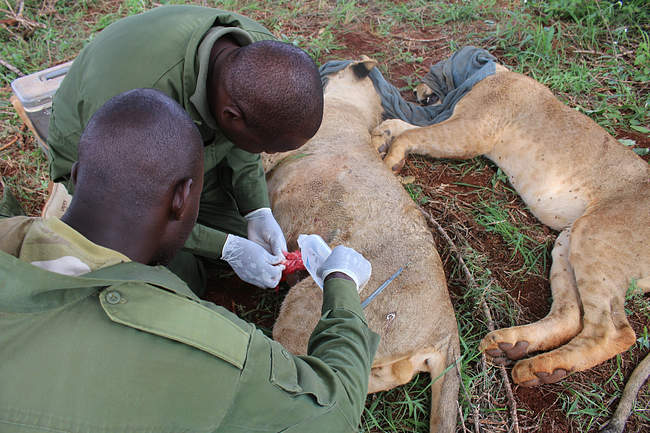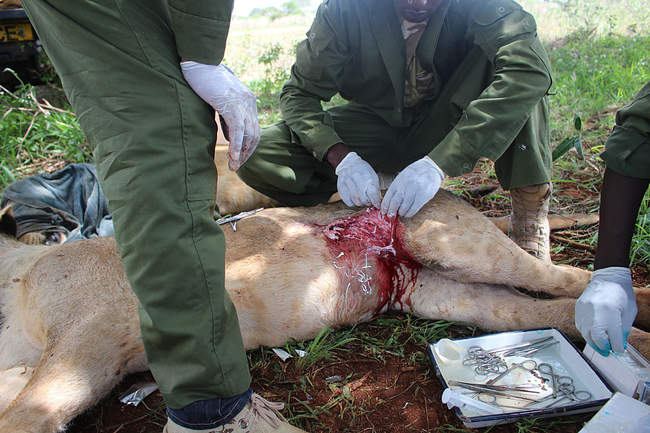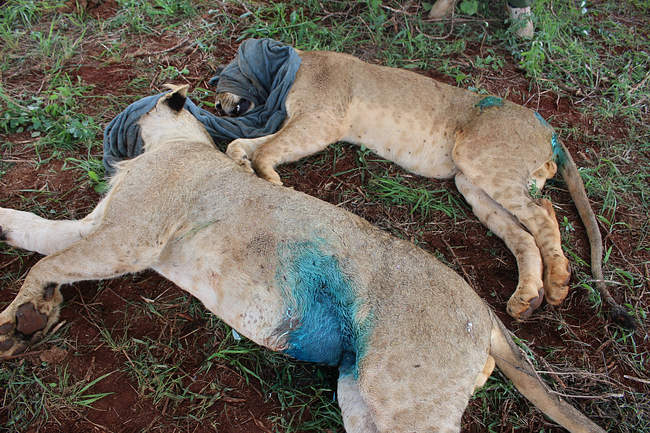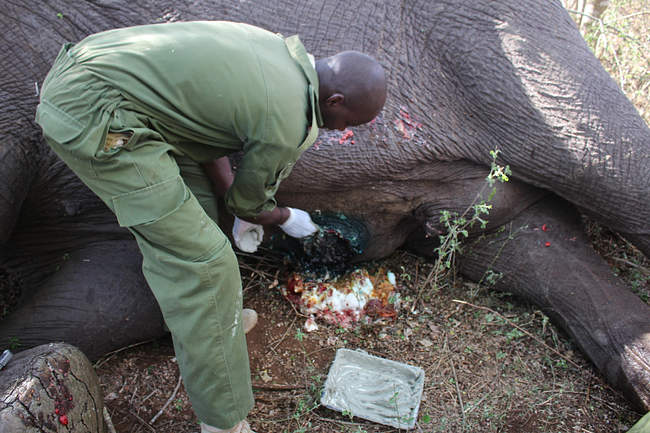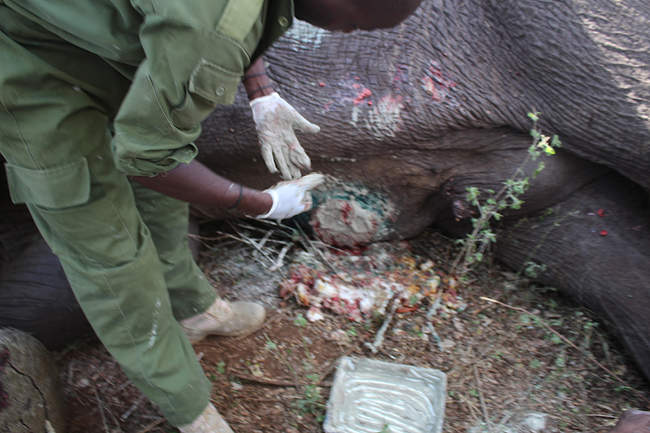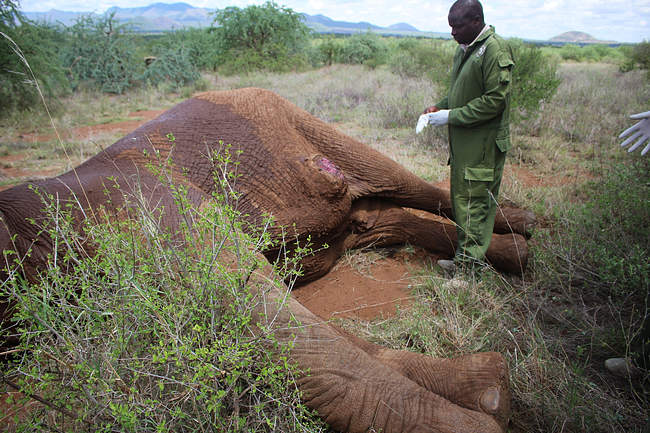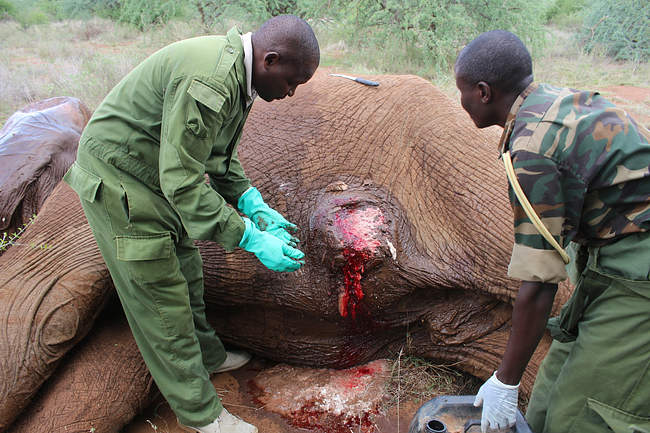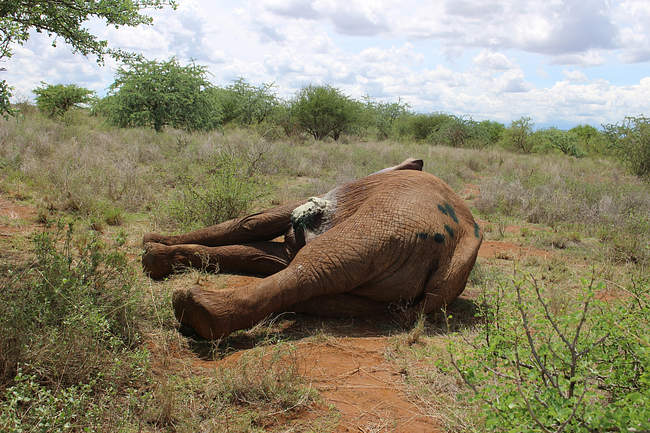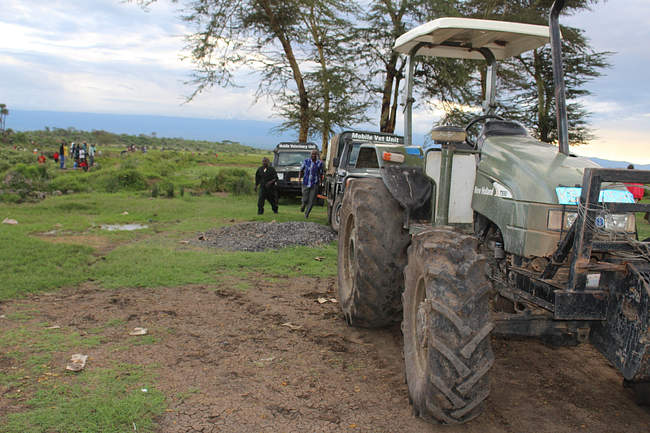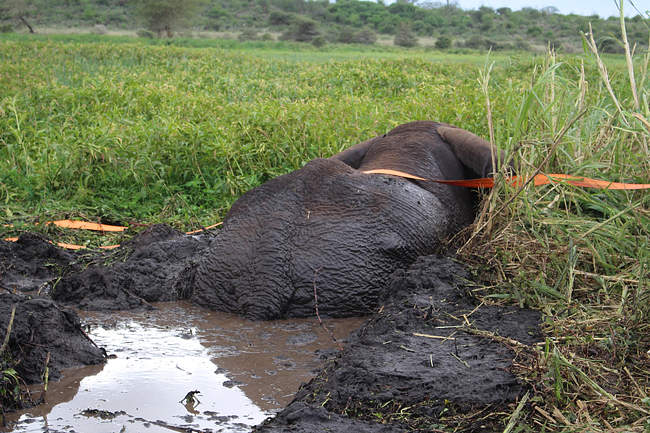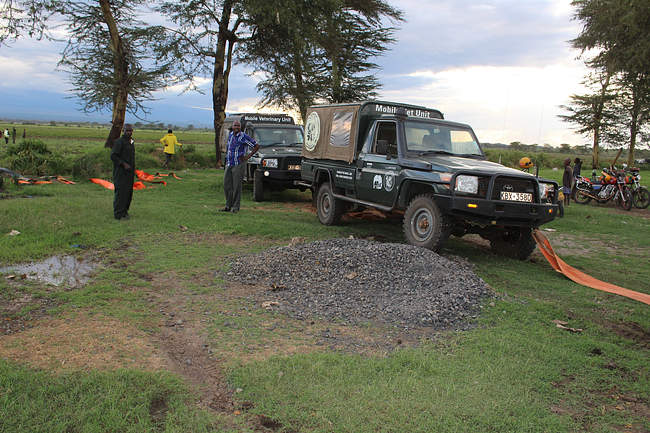The month of November witnessed an increase in cases of attempted poaching and human-wildlife conflict. Some sections especially southern parts of the Tsavo East National Park are turning lush green after a three day heavy rains received in late October and more in November.
Introduction
There were no reported cases of starvation across the region so far this year. Cases attended this month included treatment of injured Elephant bull at Ithumba in northern Tsavo East and another bull near Sentrim camp in Tsavo East all with arrow wounds, two young Lions were treated for puncture and laceration wounds after attack by Buffalos during a hunt in Ngutuni conservancy that borders Tsavo East National Park, treatment of an Elephant bull with an abdominal wound that has turned tumorous and an Elephant carcass examined both near Kitani lodge, Tsavo West. Another Elephant bull with an abdominal wound was treated in Kibwezi forest, Chyulu. Lastly a Buffalo calf was rescued after being abandoned in Lualenyi ranch, Tsavo and an Iconic Elephant bull christened “Tim” was rescued after getting stuck in muddy swamps of Amboseli.
CASE#1 TREATMENT OF AN ELEPHANT BULL
Date: 12th November 2018
Species: Loxodanta Africana (African Elephant)
Sex: Male
Age: Adult
Location: Ithumba, Tsavo East.
The elephant bull was spotted by DSWT Aerial Unit within Ithumba area of northern Tsavo East National Park with a fresh arrow wound on its body. The arrowhead could be seen still attached to the elephant and the wound was bleeding. The vet was airlifted by a DSWT pilot to Ithumba from Voi and upon arrival at the Ithumba Airstrip the vet boarded the DSWT helicopter that was waiting. The ground team drove with vehicles and tractor to the area where the elephant was last seen. The huge bull was easily spotted and approached.

Immobilization, examination and treatment: Darting equipment and drugs were prepared containing 18 mgs of M99 in a 3 cc Dan-inject dart barrel. The elephant was approached by helicopter and driven to a clear area before being darted. The bull went down after 9 minutes. The trunk and the ear were positioned correctly to aid in breathing and water splashed on the ears to cool him down. The elephant bull had a clear arrow wound on the right chest area with blood and body fluids oozing out.
Long forceps were used to probe the wound and a metallic object was felt inside. The wound was enlarged and an arrowhead was pulled out. The wound was cleaned with water mixed with Hydrogen Peroxide, doused with Tincture of Iodine and sprayed with Oxytetracycline spray. It was finally covered with green clay. Long acting antibiotics were administered intramuscularly and Dexamethasone Hcl was administered intravenously through the ear.
Reversal and prognosis: The anaesthesia was reversed by administration of Diprenorphine Hcl at three times the Etorphine dose through a prominent ear vein and thebull stood up and walked away slowly. Prognosis for full recovery is good as no vital organs were damaged.
CASE#2 TREATMENT OF AN INJURED ELEPHANT BULL
Date: 16th November 2018
Animal: African Elephant
Species: Loxodanta africana
Sex: Male
Age: Adult
Location: Sentrim Camp, Tsavo East
History: The report was made by a tour driver of an elephant with an abdominal wound that was swollen and oozing pus which they spotted while crossing the road near Sentrim Camp within Tsavo East. The vet team rushed to the scene and found the bull under a shade nearby.
Immobilization, examination and treatment: Darting equipment and immobilization drugs were prepared containing 18 mgs of M99 in a 3 cc Dan-inject dart barrel. The elephant was approached by vehicle and darted with 18 mgs of M99. He was trailed slowly from a distance until he went down after 10 minutes. The trunk and the ear were positioned correctly to aid in breathing and water splashed on the ears to cool him down. The bull had an old arrow wound on the right abdominal area with pus oozing out.
The wound was cleaned with water mixed with Hydrogen Peroxide, doused with Tincture of Iodine and sprayed with Oxytetracycline spray. It was finally covered with green clay. As there was no risk of systemic infection, the elephant was not administered with antibiotics.
Reversal and Prognosis: Anaesthesia was reversed by use of M5050 at three times the Etorphine dose. The bull stood up and walked away calmly. Prognosis for full recovery is good.
CASE#3 TREATMENT OF INJURED LIONS
Date: 17th November 2018
Species: Lion (Panthera leo)
Sex: Male (2)
Age: 2 years
Location: Ngutuni, Tsavo East National Park.
History: A report was received from one of the managers at Ngutuni Lodge which is adjacent to Tsavo East National Park that two young male lions had sustained serious injuries after a Buffalo hunt. The lions were in a large pride of 17 lion. The vet team rushed to the area to find the 17 lions in the shade of a tree. The injured lions being amongst them.

Immobilization, examination and treatment: Darts were prepared containing 200 mgs of Ketamine and 2 mgs Meditomidine mixed in a 1.5 cc dan inject dart. The 2 Lions were darted and fully immobilized after 5 minutes each after moving a short distance. Detailed examination revealed multiple puncture and laceration wounds mainly on the rear legs, abdomen, back and pelvic area. The fresh wounds were cleaned using normal Saline mixed with Clindamycin antibiotic.
One of the lions had deep puncture wounds that were stitched up using several interrupted absorbable sutures to close the severed muscle layers then the skin was closed with nylon suture. Both lions were administered with 15 cc of long acting Amoxicillin Hcl and 15cc Dexamethsone Hcl. Cause of the injuries is a suspected buffalo attack.
Reversal and Prognosis: Both lions were administered with 0.5 cc of Atipemazole Hcl intramuscularly for reversal. Post-treatment, they were both monitored to full recovery and subsequent numerous observations have indicated great improvement in their conditions.
CASE#4 TREATMENT OF AN INJURED ELEPHANT BULL
Date: 18th November 2018
Animal: African Elephant
Species: Loxodanta africana
Sex: Male
Age: Adult
Location: Kibwezi forest, Chyulu
History: The report of an injured elephant bull with abdominal wound was received from DSWT team stationed at Kenze Camp within the Kibwezi forest that is managed by the DSWT. The bull was seen that morning taking water at a nearby water trough. The vet travelled by road to Komboyo Airstrip within Tsavo West National Park and then was picked up by the DSWT Helicopter and went direct to Kenze Camp. On arrival we were directed by the de-snaring team to a forested area where the elephant had entered an hour earlier. A search was conducted by the chopper for two hours without success and when it was about time to call it a day the bull was spotted hiding beneath a tree. He was pushed by the chopper to a clearing.
Immobilization, examination and treatment: Darting equipment and immobilization drugs were prepared containing 18 mgs of M99 in a 3 cc Dan-inject dart barrel. The elephant was approached by chopper, darted and kept in an open area till he went down. Bushes covering the elephant were cleared and the trunk and the ear were positioned correctly to aid in breathing and water splashed on the ears to cool him down. There was an old arrow wound on the lower abdominal area that had healed with overgrowth of the tissues forming a tumour like growth.
Surgical excision of the wound wasn’t possible due to risks of haemorrhaging and subsequent infection from elephant mud bathing habits and rubbing against trees. The wound was cleaned with water mixed with Hydrogen Peroxide then doused with Tincture of Iodine and sprayed with Oxytetracycline spray. It was finally covered with green clay. The elephant was administered with long acting antibiotics and anti-inflammatories.
Reversal and prognosis: The anaesthesia was reversed by administration of M5050 at three times the Etorphine dose. The bull stood up and walked away calmly. Prognosis for full recovery is good.
Our mobile vet initiative is in the field every day saving wild lives
CASE#5 TREATMENT OF AN INJURED ELEPHANT BULL
Date: 19th November 2018
Animal: African Elephant
Species: Loxodanta africana
Sex: Male
Age: Adult
Location: Kitani lodge, Tsavo West
History: The report of an injured elephant bull with left abdominal injury was reported by the DSWT Aerial Unit that was patrolling the area. The bull was among 5 other elephant bulls. The vet rushed there in a vehicle and joined the DSWT helicopter that was waiting. The elephant was easily spotted nearby.
Immobilization, examination and treatment: Darting equipment and immobilization drugs were prepared containing 18mgs of M99 in a 3cc Dan-inject dart barrel. The elephant was approached by a chopper, darted and kept in an open area till it went down then the rest of the group was pushed away. The trunk and the ear were positioned correctly to aid in breathing and water splashed on the ears to keep the elephant cool.
There was an open swelling on the left abdominal wall. Close examination revealed a growth like tissues that had its roots deep in the abdomen. Attempts for incision proved difficult due to massive bleeding associated with tumour growths. Topical treatment was administered. The wound was cleaned with water mixed with Hydrogen Peroxide then doused with Tincture of Iodine and sprayed with Oxytetracycline spray. It was finally covered with green clay. The elephant was administered with long acting antibiotics and anti-inflammatories.
Reversal and prognosis: The anaesthesia was reversed by administration of Etorphine Hcl at three times the Etorphine dose. The bull stood up and walked away calmly. Prognosis is guarded.
CASE#6 RESCUE OF A BUFFALO CALF
Date: 20th November 2018
Species: Buffalo
Sex: Male
Age: Newborn
Place: Lualenyi ranch, Tsavo

Introduction and rescue: The Buffalo calf was found abandoned near Lualenyi Tented Camp by the camp attendants who reported the matter to the Tsavo Vet Unit. Observation made confirmed that there was no herd nearby as buffalo are not known to leave their calves behind. The DSWT Team was tasked with collecting the calf and bringing it to Voi for further examination. The calf was given a clean bill of health and released to the DSWT Voi Reintegration Unit for raising and eventual release back to the wild.
CASE#7 TURTLE CASE WITH FIBROPAPPILOMATOSIS
Animal: Turtle
Species: Green Turtle
Sex: Unknown
Age: Adult
Location: Watamu Marine Park
Date of clinical intervention: 23rd November 2018
History and attempted treatment: A report was made by the warden of Watamu Marine Park near Malindi of a turtle with cancerous growths on the face, neck and front flippers. The growths had covered the eyes making feeding difficult. The Turtle was spotted by private divers in the Marine Park and reported to KWS who confirmed the report.

The Tsavo Vet unit visited the Park and teamed up with both KWS and the local ocean conservation trust that deals with turtle conservation in the area. The area was visited but the oceans were not good for diving at the time. A continuous search by both KWS and private divers is underway to try and locate the turtle and save it from its misery.
CASE#8 ELEPHANT AUTOPSY REPORT
Date of Autopsy: 23rd November 2018
Carcass age: About 3 days
Species: Loxodanta Africana (African Elephant)
Sex: Male
Age: Adult
Location: Kitani, Tsavo West National Park.
Introduction: A report was made by the Company Commander based at Tsavo West National Park that an elephant carcass had been spotted near Kitani area of Tsavo West National Park after an aerial recce. Request for an autopsy was made. The Vet Unit travelled to the area by road.

General examination: The carcass was lying on the right flank and covered with tree branches to conceal it. The front part of the face was chopped off by a sharp object and the tusks were missing. The perineal area was partly scavenged by carnivores. The carcass was at mid level of putrefaction. There was a penetrating wound on the upper thoracic area, on opening the skin there was massive bleeding and muscle tissue laceration going down to the lungs. 4 ribs were broken causing further tissue damage. The object must have been launched from a raised ground/platform and usually modified with added weight to inflict maximum damage. This is a clear case of poaching.
Post mortem diagnosis: The cause of death is from massive bleeding, tissue and bone lacerations on the upper thoracic wound from a sharp object.
CASE#9 ELEPHANT AUTOPSY
Date of autopsy: 30th November 2018
Date of death: 7-10 days old
Species: Loxodanta Africana (African Elephant)
Sex: Male
Age: Adult
Location: Manda area, Tsavo West National Park.
Introduction: A report was made by the Company Commander based at Tsavo West National Park that two elephant carcasses had been spotted near Salaita area of Tsavo West National Park during an aerial recce. Request for an autopsy was made. The Vet Unit travelled to the area by road.

General examination: The carcass was lying on the right flank and at an advanced stage of decomposition with extensive scavenger activity on the carcass. The front face had been chopped off with a sharp object and the tusks were missing. The chest, abdominal and the perineal area skin had been torn away by scavengers and all internal organs either rotten away or scavenged on. The bones were checked and only scavenger bite marks were observed. The skull was checked for cracks but none were found apart from the cut damage on the front. There were sharp cut marks on the pelvis area penetrating the skin. There were no struggle marks around the carcass. The sharp object marks on the face and covering with twigs indicates likelihood of poaching.
Post mortem diagnosis: The cause of death could not be diagnosed from autopsy due to advanced autolysis and extensive scavenger activity.
CASE#10 RESCUE OF AN ELEPHANT BULL (TIM)
Date: 3rd December 2018
Species: Loxodanta Africana (African Elephant)
Sex: Male
Age: Adult
Location: Isinet, Amboseli National Park
The iconic elephant named Tim was spotted by community members in the Kimana-Isinet swamps of Amboseli and reported to Big Life Foundation that manages community areas around Amboseli National Park where wildlife disperse. The report was that the huge elephant was stuck in mud overnight and could not free himself.

The Tsavo Vet Unit boarded their vehicle and drove more than 200 kilometres to the area arriving shortly after midday. The Team was led to the area where KWS Amboseli Team, Big Life Management and rangers where waiting. The swampy area was large and it proved difficult to get machinery even to 200 meters of the nearly submerged elephant. Ropes were tied onto a tractor but could not pull the elephant due to the soft wet ground. The ropes provided by Big Life were tied together to make a 300 meter long rope and the Team started to pull Tim in the opposite direction.
Two DSWT vet landcruisers and a KWS tractor were also tied together to pull out the massive bull. Several attempts failed as the rope snapped midway. After four hours of trying, rope snapping and uncontrollable community swarming the site, Tim was finally pulled out of the mud trap. He struggled to stand on his feet and had to be assisted by being pulled by his tusk. He stood up with struggle and walked carefully out of the muddy swamps to the relief of the team. We are glad to have saved this priceless massive animal.
Other activities
The Unit Vet testified in 3 cases, at the Voi Law Courts, where offenders were charged with being in possession of wildlife trophies.The Unit administered prophylactic Triquin injection on KWS canines based at Ngulia Rhino Sanctuary within Tsavo West National Park for Trypanasomosis prevention/cover.
Acknowledgement
Report by KWS Vet Dr Poghon. The unit acknowledges the support of its sponsors ViER PFOTEN through the David Sheldrick Wildlife Trust (DSWT) for their immense financial contribution to the unit. We also thank Kenya Wildlife Service through the Assistant Director Tsavo Conservation Area and the Head, Veterinary and Capture ServicesDepartment for their support.
